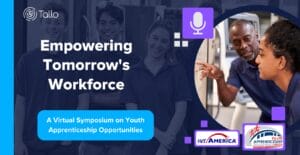
It’s an age-old problem. Businesses struggle to find workers with needed skills and experience, while young people or transitioning workers want to find good work, but often lack the requisite skills and experience.
What to do? In this new era of intense labor shortage, it might seem like anyone and everyone who is still interested in work would be highly sought after and catered to. But because we live in such a highly developed, fast-paced, and knowledge-based economy, skills and experience are absolutely vital. Employers and job seekers need simple steps to bridge the gap.
Historically, the approach has been to go to college, get a degree or certificate, and then pound the pavement (or, more recently, the internet) to find those good entry-level jobs at the companies that can help you break into the labor market.
But given the intensity of the current labor shortage, the fact that many people don’t want to wait years before launching or upgrading their careers, and the robust wages that desperate firms are now offering, the degree or certificate track is less appealing to many potential workers.
What’s the solution?
Hire them now and train them for what you need. Essentially, the key to success for most firms is to invest in new talent–even if that new talent isn’t ready yet.
Many businesses may simply prefer competing for talent on the open market. But because they are now competing against many other companies for an ever-dwindling pool of already-experienced talent, it is high time to expand the horizons a bit, think strategically, and make bigger investments in early or transitioning talent.
But even for businesses willing to build their own talent, the prospect may seem daunting. The list of common objections runs something like this:
- Who is going to oversee the training?
- What’s the budget?
- What’s the time frame?
- We just need people now. This will take too long.
- The business wasn’t set up for that kind of program.
These concerns are all valid. But for the businesses willing to try, the rewards of this can be enormous. And for those that refuse, there’s no clear backup strategy available for dealing with labor shortages.
Luckily, there’s a good starting point for these hurdles: apprenticeships and internships.
Internships Vs. Apprenticeships Infographic
Internships, usually given to promising students or new entrants to the labor force, are short-term work assignments in an occupation or specific subject matter within a company. The internship pairs the new worker or student with someone more experienced. Ideally, this means that it’s both a learning experience and a real productivity boost for the company in question. Work gets done, and the company can use the time to evaluate whether the candidate is the right fit for their company. Meanwhile, the student or worker can evaluate whether they like the work or company enough to pursue a career there. The internship may be full or part-time, paid or unpaid, but it should be a win-win for both parties.
Apprenticeships are similar but tend to revolve around skilled trades. In an apprenticeship, the employee is there to learn a discrete skill or trade. Often, they are completing related coursework at the same time. The employer has to invest in training for the trade-in question, but at the other end of the program, essentially has a new employee tailor-made for the company. The employee gains new skills, tests a company out, and often gets an industry-recognized credential. Today as early talent considers employment and what route to take, 79% of them are interested in working in a paid and structured training environment that will lead to full-time employment. That’s huge. Companies cannot afford to neglect such opportunities. Another win-win in the world of employee-employer relationships.
94% of students want to pursue internships and apprenticeships
Want another reason to invest in an internship or apprenticeship program to find new talent? We actually found that a staggering 94% of high school and college-age students believe that it’s important to have an internship or apprenticeship program before a full-time job. Further, 74% say that they would consider something like an internship over a four-year path. That is just amazing and such a huge shift in the market. If you want to tap into this audience, we’d be hard-pressed to find another more effective approach.
Early talent struggles to find them…
For all the encouraging stats here, it must be noted that 73% of the people interested in internships and apprenticeships admit that they do not know where to find out about such opportunities. A slim majority (51%) believe that internships and apprenticeships are out there, and the struggle largely relates to finding them. This is not an insurmountable task and it goes back to what we have talked about a lot lately – be present early and often. Build that employment brand and make sure that people know that you have opportunities. In many ways, this relates back to something that Peter Drucker referred to as the central function of a company: “Because the purpose of business is to create a customer, the business enterprise has two–and only two–basic functions: marketing and innovation. Marketing and innovation produce results; all the rest are costs. Marketing is the distinguishing, unique function of the business.”
We think the same rule applies to finding talent. You must have a company that produces a great product and service and then you must make sure potential employees know about you and know that you have opportunities (like internships and apprenticeships) for them. Some 70% express that learning about employers with apprenticeship programs would be helpful, and the top employers that people believe have good internship/apprenticeship programs are Amazon, New York Times, SpaceX, Wells Fargo, and IBM.
Click here to download the Internships Vs. Apprenticeships Infographic
The benefits of developing internship and apprenticeship programs
Not convinced yet? Well, here are four more reasons why companies should give internships and apprenticeships a try.
- Internships and apprenticeships allow students to develop their professional connections.
As we discussed in an earlier post, our surveys show that 50% of early talent prefer traditional resumes over video-based ones. By and large, early talent doesn’t want to network with businesses on the same sites they use to communicate with their friends.
But they are very interested in finding on-ramps to good work—it’s just hard to know what those on-ramps are. And that’s exactly what an internship or apprenticeship provides: a chance to become acclimated to professional culture, learn basic workplace norms, gain valuable experience and skills, and connect with mentors who can help them throughout their careers. A majority of early talent—58%—said they would prefer to find information on apprenticeships and internships through the company website. It’s not a matter of jumping through hoops to speak their language, just conducting basic outreach.
- Internships and apprenticeships impart a sense of company culture and vision
Tallo’s data shows that 88% of early talent prioritizes meaning over money when it comes to making career choices. While they’re eager to thrive in a professional setting, their aspirations are often less about climbing the corporate ladder and more about doing work they believe makes a difference in the world. This is further evidenced by the fact that 74% of students would take an unpaid internship if it were related to their dream job.
By offering an internship/apprenticeship, you have a chance to communicate your company’s purpose and mission in a visceral way. Early talent can see what it feels like to work on key projects and envision their role in the company’s future. Getting them to think about how a meaningful, fulfilled life might involve your company—before they graduate from higher education—is crucial. Seventy-nine percent of surveyed students said they were most interested in paid and structured experiences that lead to a full-time job. In other words, if you can bring them in with an internship or apprenticeship, early talent will want to work at your company afterward.
And again, this is precisely where they want to start engaging with the labor market—while they are still students. 71% of early talent say they are choosing the company they would like to intern at while they are still in high school and early college. Chances are, once they enter the market full-time, they will choose the companies that provide those early engagements and opportunities.
- Internships and apprenticeships allow companies to develop skills in future hires.
Let’s face it: talent is expensive. It’s especially expensive for high-demand, cutting-edge skills. Companies can spend thousands and thousands finding and recruiting experienced talent, even before you consider the high salaries their resumes command. And even after all this hassle, chances are you’ll still have to do significant on-the-job training to help new employees understand how best to apply their skills in the context of your company.
With a solid internship or apprenticeship program, you kill two birds with one stone. By training students in high-value skills before their first full-time job, you can create a much less expensive talent pipeline for your business. NACE reports that companies have a 56% success rate when trying to convert interns to full-time employees.
And because interns are developing skills in the context of your specific business, you’re reducing the cost and effort of onboarding as well. It’s a win-win—just like internships/apprenticeships themselves.
- Internships and apprenticeships create a powerful connection between your business and early talent—right now.
Chances are you don’t work for Netflix, Google, Facebook, or one of the handful of brands that have an immediate recognition factor in the minds of early talent. To make them aware of your brand, mission, and opportunities, you need to go to them.
Tallo surveys found that 63% of early talent are ready for internships and apprenticeships right now. They don’t have a theoretical wish to participate in an internship or apprenticeship someday. They’re ready for one now.
But here’s the problem: when surveyed, 73% of early talent said they didn’t know how to find information on apprenticeships. To connect with these eager-to-work young people, you need to reach out to them.
Tallo recently worked with a large firm that was unsure how to reach a new generation of talent. Using Tallo’s platform, they looked at their most needed skills and put out a call for applications, offering to train students in those skills.
The response was overwhelming.
Not only did the company find interns, but through the application process, they opened a communication channel with hundreds of bright, engaged young people. That channel will yield rewards for years to come.
Subscribe to receive Tallo Data Insights
straight to your inbox!




